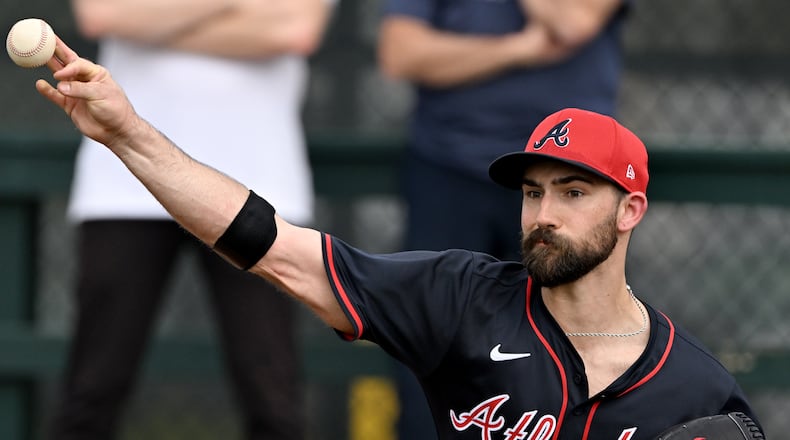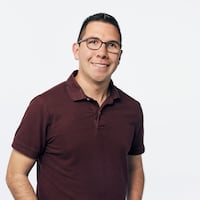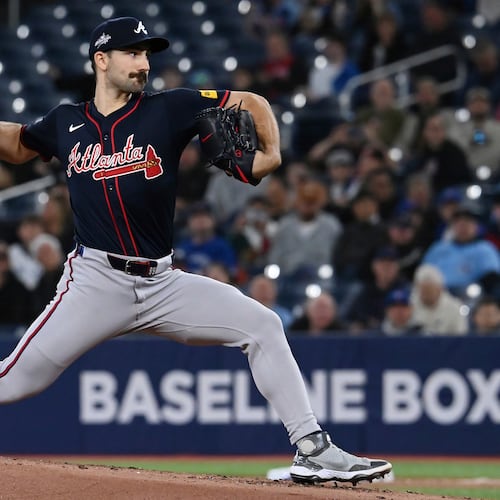NORTH PORT, Fla. — After throwing four innings against the Diamondbacks at Truist Park in an April start last year, Spencer Strider exited the game and went into the tunnel and toward the training room. He knew. He had experienced this feeling before.
Strider went into the training room and told the trainers he was hurt. He needed an MRI, he said. He wanted to begin the process. He already had accepted it: He had blown out again.
So he sat on the training table, and his first thought was …
“This is great,” Strider told the trainers.
Uh, what?
Great?
“Don’t give me this opportunity,” Strider said.
This right here is Strider. Accepting. Fearless. Determined. Committed.
Think about it: In that moment, he knew deep down that he likely needed another elbow surgery to repair and stabilize his ulnar collateral ligament, but his first thought was to relish the road ahead. He understood he had lost the season, but his focus went to making the most of the year in front of him.
For years, Strider has worked with Dr. Cory Shaffer, a sports psychologist. The moment depicted above? Strider has been trained to think this way. But the scene serves as a look inside his mind as he faced a rehab year.
At some point shortly after opening day, Strider will return to the mound for the Braves. It will be around a year after the internal brace elbow procedure he underwent last April. To reach this spot, he had to stay patient and purposeful throughout this past year.
Recently, Strider sat down with The Atlanta Journal-Constitution for a lengthy interview on his last year. He went through everything from the mental game to his mechanics.
This is a breakdown of Strider’s rehab journey, month by month.
February and March 2024
This all began in spring training. As Strider ripped through the competition — he allowed only two runs over 22⅔ innings — he sensed something might be wrong.
“You never feel good all the time,” he said. “The healthiest of guys who pitch the longest, have the least amount of injuries, there’s absolutely times where they’re like, ‘Am I OK? Does my arm hurt?’ Especially nowadays. You’re aware of the fact that you could have this injury and that injury, and that stuff going on. Obviously, I’ve had an elbow injury (before this), I’ve had TJ, so I know what that’s like — that distinct feeling. I, pretty early on in spring, was like, ‘Yeah, this is a little different. This isn’t just rust wearing off.’
Strider didn’t tell the trainers anything until he exited that start against Arizona. As he received treatment in the spring, as he normally would, he thought, Well, hopefully this works a lot better than it has in years past because I think I really am hurt.
When he told the trainers about it, Strider had no doubt in his mind: He needed another elbow procedure.
The pain he’d experienced was … different. It lingered. He couldn’t escape it.
Strider and Shaffer do a lot of mental practice to help Strider detach from how he feels when pitching. The idea is that when he’s trying to compete, how he feels physically has no influence on getting guys out. He has to pitch with what he has and how he feels that night.
“That subjective feedback is important to adjust routines, adjust preparation, optimize,” Strider said. “But I’m usually able to detach myself from that feeling once it’s time to compete, and in spring, I was unable to do that. That’s how uncomfortable my elbow was. For somebody who has not been hurt to that degree — you can’t ignore it. It’s unavoidable. That’s when you know this might be something more severe. There’s not a moment, there’s not a pitch where I go, ‘Hey, I didn’t think about my elbow right there.’ No, it’s constant. There’s no amount of mindfulness that can detach you from it.”
April
On April 12, Strider underwent internal brace surgery to repair his damaged UCL. In short, a bone fragment had developed that destabilized the ligament.
“A lot of, just, discomfort,” Strider said of the period right after surgery. “It’s pain that’s hard to ignore. You’re not sleeping, you’re just not comfortable.”
Strider estimated he didn’t sleep well for two and a half or three weeks.
“Your shoulder starts aching. It’s just unavoidable,” he said. “And it gets better over time. I’m not a back sleeper. You can’t sleep on your side — either side — at that point. You’re still in a sling at night, you still got stitches, it’s just sensitive, the area doesn’t feel good. In the moment, that feels so obnoxious to you, but it’s like, this is such a small — that’s kind of how I feel with anything. This current situation, good or bad, is such a small blip, hopefully, on the spectrum of my life that, like, what sense do I have in really dwelling on it? Let’s just distract myself. Let’s find other things to do — which can be hard when you’re limited, because you got a surgically repaired elbow. But yeah, that’s part of the process.”
May (Part 1)
When Strider was at Clemson, he was stubborn and set in his ways. “I still am,” he joked in the middle of saying that. His Clemson coaches wanted him to improve the mental part of his game because it was holding him back.
The coaches demanded Strider see Shaffer, who over a successful career had worked with Clemson athletes and many others. Strider finally agreed. The day before he met with Shaffer for the first time, he blew out for the first time.
So, when Strider — who required Tommy John surgery — saw Shaffer for their meeting, he said: “Hey, it’s gonna be different, because now we’re rehabbing an injury.”
“Well, that’s actually great,” Shaffer told Strider. “This is the perfect time, then, for you to start doing this, because what you’ve gotta understand is that this is an opportunity, and because of this, you will be a better player — not ‘you will still be a good player despite this.”
Strider keyed in on that last part. He wouldn’t become a better player despite this, but because of this.
“I think that there’s an ego or a pride that is appealing to people — in any context, not just baseball — to say, ‘I succeeded despite this thing,” Strider said. “These people or this situation or this adversity tried to stop me, and I persevered despite it.’ That sounds great, that sounds tough, but that’s not the most pragmatic way to look at things. It should be, again, accept things the way that they are, not the way you’d want them to be, because that’s truly the only way forward.”
Thus began Strider’s mental transformation, something that has been crucial in him reaching these heights early in his career.
So, when Strider sat on the table and said it was “great” that he would be going through another rehab process? He learned it. He trained it. He’s worked at it.
Of course he wanted to pitch.
But he knew this would simply be delayed gratification.
“Everything’s delayed gratification,” Strider said. “Even a healthy player’s process is delayed gratification. We do all this work — all the offseason, the whole season, in between starts, on a daily basis, for something that happens in a fleeting moment, or at the end of the season. That’s what this is. And once you can understand that and you can enjoy that excitement and that potential that comes with that opportunity of this process, then I think it allows you to be honest, be humble and learn. And that’s really what I’ve enjoyed.
“There’s just no question that — not in an arrogant, but in just a raw, like accumulation of information — I’m a smarter person and player as a result of this than I would’ve been had it not happened to me. I’d have a different set of experiences and would’ve gained a different set of information had I stayed healthy and experienced whatever pitching last year would’ve looked like. But that didn’t happen. I’m where I’m at now, and I wouldn’t know the things I know now had I not gotten hurt. So, it’s like, you gotta just accept that this is — it’s not part of the plan, I don’t think that way. There’s a Stoicism concept that is, ‘You will find peace when you start accepting things the way they are rather than the way you want them to be.’ I think that’s it. That’s an injury. It’s just, well, what’s the reality of the situation? How do I move forward?”
And so Strider moved forward.
Credit: HYOSUB SHIN / AJC
Credit: HYOSUB SHIN / AJC
May (Part 2)
Before the injury, Strider had a lot of plans for the team in terms of how he might be able to help, both on and off the field. Some of those: Trying to spread awareness to the mental side of the game, improving culture, boosting confidence, encouraging teammates to share their experiences with the mental game.
And now, he was hurt. He wasn’t around. He couldn’t even be in the dugout.
“And so I tried to do stuff, I tried to be involved,” he said. “But at the same time, I think, in that moment, and this is kind of what I’ve realized — kind of going back to just thinking about spending time in your mind on things that aren’t essential. If I’m not taking care of what I need to do — ultimately, the best thing I can do for the team is be a good baseball player. That’s gotta come first. Rather than be upset over not being involved, not traveling, not being around, I can’t be in the dugout, let me do my work well. Because if that frustration, that’s valid, detracts from the quality of my rehab, well then what have I done? That’s basically where I had to get my mind, was, ‘I need to just attack what I control.’”
At one point last season, Strider had Shaffer talk to the Braves. To Strider, it seemed beneficial for everyone. But he also understands it’s difficult to expose someone to something they don’t understand. Remember, he was the same way at Clemson before working with Shaffer.
“There is a benefit here for everybody,” Strider said. “And what it looks like for you is different. To ignore any part of development, you’re doing yourself a disservice. You’re missing out on potential gains. You want to bring up the floor developmentally as a player, as a person. You can’t just focus on one area and improving that part, because there’s gains to be had everywhere. Everything needs to continue to improve. Everything can be optimized.”
This entire process — the helplessness he felt because he couldn’t impact change as he wanted — began in May and lasted for months.
“I think it was toward the end of the season, into the offseason, really, that I think I kind of re-acclimated myself to the idea that there’s no sense in forcing a desired outcome or situation,” Strider said. “This is the way things are. These people or this person is gonna do what they’re gonna do, and I can’t control them. I can’t control other people, I can’t expect certain things. I have high expectations for myself, and I have unfair expectations for everybody else, and that includes coaches and players and everybody.
“Ultimately, I want to be the best I can be, and I want the team to be the best they can be, more than anything. I want everybody to pull the rope as hard as they can, and I want everyone to be on the same page. I want everybody to feel the same way I do because I want it so bad. You know what I mean? That’s not fair to everybody, because I know everybody has got a different experience and they all care in their own way. And I have a hard time rationalizing that to myself sometimes. And I’ve realized the best thing I can do for everyone is make sure that I’m the best player possible, that I give us the best chance — (that) I do my job as well as I can.
“You take those opportunities to make other people better as they come, just like forcing the mental game upon me, like they did in college, was not very effective for a long time. And that’s kind of the same thing with other people. It’s like, if you want to influence change, it’s gonna work and look different for everyone at every time.”
June and July
In these months, Strider’s work in the weight room began to increase. He had a message for Brad Scott, the team’s head strength-and-conditioning coach: “Look, don’t hold back here.”
Strider wanted to get in the best shape possible.
“I have a high training age, he knows that I’ve been working out since I was 14,” Strider said. “I can do certain things in the weight room and accomplish certain things that other guys can’t because they just haven’t spent as much time — they’re not as experienced with it. And I’m not looking to feel good, I’m looking to grow, literally and figuratively. I want to be challenged here. And that’s something that was important in the rehab process. I don’t have on-field experience to challenge me. I still need to grow, and that comes from stimulus. Basically, it was like, ‘I want to walk out of here most days mentally and physically challenged,’ and I got in a lot better shape as a result. That was really when we built the foundation to do some of the specialized, transferable mechanical work that we started to get into in the latter half of summer and into fall.”
Strider did a lot of aerobic and plyometric exercises. He did intervals on an Echo Bike to elevate his heart rate. He did a lot of work with a weight vest. He wanted to fatigue himself. He attempted to build a base that would allow him to be strong in baseball-specific positions.
Then came the start of the mechanical work.
August and September
Strider knew his injury — the bone spur developing where it did — might have been unavoidable. Still, he tried to evaluate his mechanics and see if anything could’ve led to it. He wanted to be better.
He landed on trying to improve things like his lower-half timing and having a loose, free upper body while pitching.
The problem: He still couldn’t throw. So how could he practice his mechanics?
In conjunction with Sean McLaughlin — a former Braves minor leaguer who runs the pitching side at Maven Baseball Lab in Atlanta — Strider engaged in an experiment. At Maven, he held water bags on a force mound — which tracks how a pitcher applies force and the timing of that force — and twisted his body, as if to mimic pitching.
The water moves, which mimics a pitcher’s transfer of weight. Previously, the thought was that you couldn’t replicate a pitcher’s movement. But Strider and McLaughlin found a way, and discovered Strider’s force metrics with the water bag was similar to throwing a baseball.
And months later, when Strider threw his first bullpen session, he had the best lower-body mechanics he’d ever had based on measurements.
“It carried over very well,” he said of the water-bag experiment.
This experiment actually went well with Strider’s general philosophy on mechanical changes like this. He believes data and technology can provide feedback and parameters better than his own subjective analysis. So if he steps on a force plate and the metrics are good, he can train his mind that this is what a good rep feels like.
“To me, what makes more sense for long-term success is to try to get your mind and your body to feel what’s actually happening,” he said.
October, November and December
In the first week of October, Strider began throwing from 60 feet on flat ground. In the coming months, he began building up as he entered the final stretch of the rehab process.
Throughout the entire rehab process, Strider read tons of books and played more guitar. He’s a fan of Ryan Holiday, an author whose books incorporate tenets of stoicism. He devoured a ton of books on performance. Recently, he read “The First Rule of Mastery: Stop Worrying About What People Think of You” by Michael Gervais. He consumed author Scott Galloway’s books.
Next on his list: “The Barn: The Secret History of a Murder in Mississippi” by Wright Thompson, which is about Emmett Till.
January, February and March 2025
Strider threw his first bullpen session in January. Since then, he’s been throwing them every Tuesday and Friday. Eventually, he’ll graduate to live batting practice. The Braves think Strider can pitch in a spring training game before they leave camp.
Eventually, he’ll be back.
Or maybe we shouldn’t phrase it quite like that.
“Very aware of the concept of delayed gratification,” Strider said. “I think people who have not experienced anything in the field of baseball or performance or sport think that — even the language in the industry often results in, “Well, he’s done with rehab, he’s back.” Well, that doesn’t make any sense. I don’t expect perfection from myself. I expect my best effort, my best available work ethic, that kind of stuff. I’m not thinking about being perfect my very first game back in the big leagues. Obviously I want to do well, I want to help the team. I’m thinking about accumulating experience and skill and growth toward not just when I am pitching in big league games, but hopefully in the postseason next year, the year after, over the course of my career. This is just another data point on the graph of, hopefully, what is incremental improvement over the course of my career.”
The notebooks
Since 2019, Strider has cataloged his entire baseball life. He’s written — subjectively and with objective data — about every single outing. He’s even documented his two rehab processes. He’s put a lot of this into Google Docs, but he has six or seven small notebooks full of information.
Shaffer, his sports psychologist, thinks they’re helpful. The Braves’ trainers, and pitching and strength coaches, also find them useful. And Strider figures that eventually he’ll be able to help teammates with the information he can recall.
His 2024 notebook became a log of the rehab year.
When he returns to a big-league mound, he’ll begin the 2025 notebook.
About the Author
Keep Reading
The Latest
Featured




